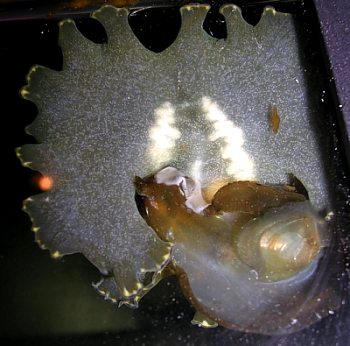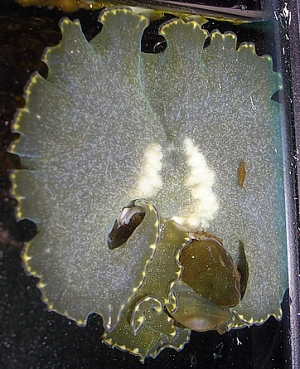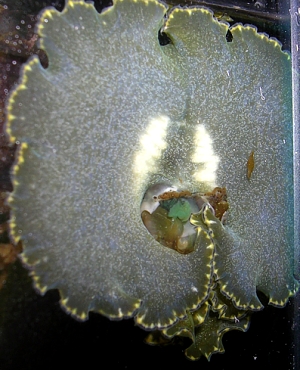Aplysia juliana eaten by Flatworm
April 10, 2006
From: Lisa Kirkendale

Hi Bill,
I thought you would be interested in these aqarium observations of a flatworm which ate an Aplysia in our aquarium recently. It fortunately did it on the side of the tank so I was able to take these photos through the glass. Following the Aplysia sp., the flatworm then proceeded to eat a specimen of Chelidonura inornata (unfortunately I didn't get any good pictures of that). The animals were all collected locally around Sydney [NSW, Australia].
A friend of mine, Raphael Ritson-Williams has tentatively identified the flatworm as Paraplanocera oligoglena. We were both grad students at the University of Guam Marine Lab, and he has recently published on a flatworm in Guam which harbours the neurotoxin, tetrodotoxin. The planocerid he was looking at ate a variety of marine snails from at least 11 families, and also a species of Elysia.
-
Ritson-Williams, R., Yotsu-Yamashita, M. & Paul, V.J. (2006) Ecological functions of tetrodotoxin in a deadly polyclad flatworm. Proceedings of the National Academy of Sciences (PNAS), 103(9): 3176-3179.
Sincerely,
Lisa Kirkendale
fragum4ever@yahoo.com


Thanks Lisa,
This is an interesting observation. Its common knowledge that flatworms are carnivorous but actually catching them in the act is not that easy. Its certainly not a good week for Sea Hares as its only a day or so since we posted the message about Aplysia californica being eaten by Navanax [message #16251]. Although not an expert on flatworms I have been using Paraplanocera oligoglena for this animal [see Fact Sheet], on the advice of Leslie Newman. I am pretty sure the sea hare is a small Aplysia juliana which may explain why it did not excrete any purple ink in its distress.
For those not familiar with flatworm anatomy, these animals have a 'mouth' on the underside of the body so essentially they can catch their prey by walking over the top of them and sucking them in.
Best wishes,
Bill Rudman
Related messages
-
Sea hares from Tristan da Cunha
From: Sue Scott, June 1, 2010 -
Aplysia juliana? from Reunion Island
From: Philibert Bidgrain, January 31, 2007 -
Re: Aplysia juliana in my aquarium
From: Michelle Yerman, May 25, 2006 -
Aplysia juliana in my aquarium
From: Michelle Yerman, May 19, 2006 -
Re: Sea Hares laying noodle shaped things in tank
From: Marcus van Riet, December 17, 2005 -
Sea Hares laying noodle shaped things in tank
From: Marcus van Riet, December 6, 2005 -
Aplysia juliana? in Kiama rock pools, NSW
From: Francis Hawkshaw, August 9, 2005 -
Aplysia juliana being eaten by crab
From: Dong Bum Koh, June 7, 2005 -
Aplysia juliana laying eggs
From: Dong Bum Koh, May 25, 2005 -
Aplysia juliana - breeding in Tasmania
From: Melanie Godfrey-Smith, November 16, 2003 -
Aplysia juliana - breeding in NZ
From: Paul Furneaux, August 16, 2003 -
Aplysia juliana from New Zealand
From: Paul Furneaux, June 30, 2003 -
Sea hares, mating pair - from Sydney
From: Iain Whyte, November 30, 2002 -
Aplysia juliana from Korea
From: Ronald Noseworthy, June 19, 2002 -
Re: Aplysia from Taiwan
From: Tony Wright, April 16, 2001 -
Aplysia from Taiwan
From: Tony Wright, April 14, 2001 -
Sea Slug feeding and babies
From: Andrew McDonald, February 16, 2000
